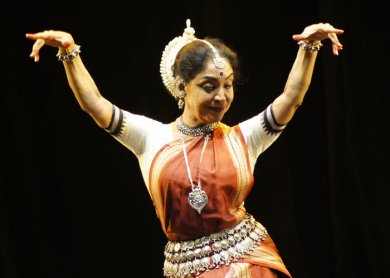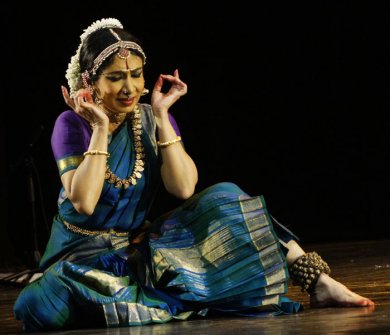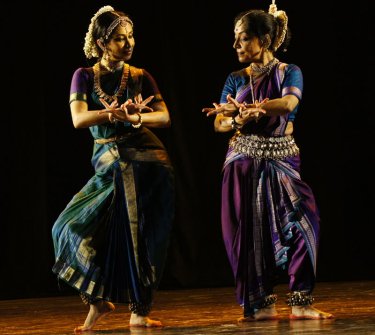
|   |

|   |
Two rivers meet in an ocean of dance - Shveta Arora e-mail: shwetananoop@gmail.com Pics: Anoop Arora March 22, 2015 This vibrant arts scene in Delhi brought with it Vasantotsav, which was organized by Kalashram on the 25th, 26th and 27th of February at the Kamani Auditorium. The evening began with Dr. Kapila Vatsyayan being honoured with the Achchan Maharaj Kala Jyoti Samman by Pandit Birju Maharaj. It was a pleasure to see a very lively Kapilaji, despite her not being too well that day.  Pt. Birju Maharaj & Dr. Kapila Vatsyayan  Madhavi Mudgal The performers of the evening were Madhavi Mudgal and Alarmel Valli. Madhavi Mudgal began her solo with verses from the Atharva Veda, where earth is described as the sustainer of all life -the land sustaining the flora and fauna and the rivers and seas sustaining aquatic life. The piece culminated in a pallavi celebrating life. The nritta piece was meticulously executed by Madhavi. Music was composed by Madhup Mudgal. Next was a composition of Goswami Tulsidas, detailing the sentiments of Lord Rama’s mother Kausalya when she hears about him leaving for fourteen years of exile. It was a piece choreographed 40 years back by Birju Maharaj for her when she was learning from him. The lyrics bring out the pathos of the situation - Rama kaun jatan ghar rahiye (O Rama! What will prevent you from leaving the house?). Madhavi’s abhinaya was slow and measured. She depicted Rama without his ornaments, his hair tied in a knot on his head, like a tapasvi. Kausalya beseeches Rama not to leave the palace. He is the same lad who played with her and embraced her and is now leaving her. He is the same child whose sweet voice she would hear and now she is hearing the news of his leaving for exile for fourteen years. Madhavi skillfully brought alive these emotions in her dance, as the mother reminiscing about the past and her helplessness in the present situation. Alarmel Valli performed a padam in raag Charukesi, taal misra chapu. It was a composition by fifteenth century Telugu bhakti poet Annamacharya. In the poem, the devotee is agonized and bewildered since he is yearning for the divine. The poet draws upon the irony of the situation - by what means can I reach you, infinite Lord? Without beginning or end, I want to worship you fittingly with my hands but you are huge and encompass all space. Valli’s depiction portrayed the four-armed stance of Lord Vishnu. The bhakta performs seva by bathing the idol, making chandan and applying it, stringing flowers into a garland and finally, doing the aarti. But the Lord to whom the seva is being offered encompasses the whole universe (vishwakaya). The bhakta says that he wants to gift the Lord something desirable, but he is the very embodiment of all desires (sakalakamana). ‘I long to see you with my eyes, but I find that you have no visible form. What else is there for me but sharanagati / surrender? O Lord Venkateswara!’ The mesmerizing abhinaya brought out the anguish of the devotee as he feels defeated. The hand and foot movements were precise and sharp. The next piece was Jaanaro, a javali in raag Khamas, taal rupakam attributed to Ramanad Srinivasa Iyengar. The nayika tells her friend that she is longing for her beloved. Radha celebrates her love and desire in a sensual mood. She is being peppered with arrows by Manmatha, and cannot bear the longing. Memories of her union with Krishna fill her with delight. Would the sakhi be her messenger to Krishna? Valli portrayed Kamadeva shooting the flower arrows. She asks the parrot to be quiet, since his voice is tearing at her. Covering the stage well, Valli captured the gait and attitude of the heroine as she is decking up and braiding her hair while admiring herself in the mirror. As perfect as her abhinaya were her complete movements, hastas and footwork  Alarmel Valli  Alarmel Valli & Madhavi Mudgal ‘Samanvaya,’ a pure dance piece was the culmination of the performance. It was the coming together of two doyens of two dance styles while still asserting their individualities. Both Mudgal and Valli made the dance and the musical genre of their forms come together. The lighting highlighted just the feet of the two dancers as the performance began, focusing on their footwork. In the woven tapestry of the two forms, the movements of both were juxtaposed to bring out their differences and similarities. The fast and sharp movements of Bharatanatyam were in sync with the fluid and wavy movements of Odissi. And yet together they looked so much in rhythm that it was a pleasure to watch. The music by Madhup Mudgal, Prema Ramamurthy and Lalgudi Sriganesh enhanced the whole experience. About the last piece, Madhavi said, “Valli and I have been friends, and to create something like this, you have to connect in your thoughts and inner self. We have used corresponding movements from both styles. The music too had to be worked on.” Valli added, “This piece has been in the making for some time. Every movement has to be juxtaposed against the other, as a foil against the other - some movements have been similar, some contrasting. We have used the strengths of each style. The piece took us about three months to complete. First, it was the music composed by Madhup Mudgal, with Prema giving the Carnatic inputs and then the contribution of percussionists. Each movement was worked out bit by bit. My mother was the third eye to our rehearsals, giving her inputs.” Shveta Arora is a blogger based in Delhi. She writes about cultural events in the capital. |